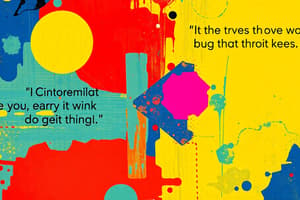Podcast
Questions and Answers
What is the main function of visual imagery as described in the passage?
What is the main function of visual imagery as described in the passage?
- To enhance taste perceptions
- To create mental images similar to those seen with the eyes (correct)
- To help people remember sounds
- To stimulate autobiographical memories
Which of the following is NOT an example of auditory imagery?
Which of the following is NOT an example of auditory imagery?
- Music
- Ambient noise
- Voices
- Colors (correct)
How does olfactory imagery contribute to memory and emotions according to the passage?
How does olfactory imagery contribute to memory and emotions according to the passage?
- By generating internal sounds
- By enabling people to visualize colors
- By enhancing auditory perceptions
- By stimulating memories due to its strong connection with autobiographical recollections (correct)
Which type of imagery allows individuals to recall events, solve problems, and daydream?
Which type of imagery allows individuals to recall events, solve problems, and daydream?
What is the primary function of auditory imagery?
What is the primary function of auditory imagery?
How does visual imagery expand cognitive horizons according to the text?
How does visual imagery expand cognitive horizons according to the text?
What type of imagery pertains to the experience of taste?
What type of imagery pertains to the experience of taste?
Which type of imagery involves textures, pressure, and temperature?
Which type of imagery involves textures, pressure, and temperature?
Imagining biting into a piece of chocolate cake without consuming it physically is an example of which type of imagery?
Imagining biting into a piece of chocolate cake without consuming it physically is an example of which type of imagery?
What type of imagery helps people develop motor skills through simulated actions?
What type of imagery helps people develop motor skills through simulated actions?
Envisioning a sweet berry pie while feeling its texture against your fingertips demonstrates the fluidity between which two types of imagery?
Envisioning a sweet berry pie while feeling its texture against your fingertips demonstrates the fluidity between which two types of imagery?
Which type of imagery can evoke both auditory images and visual impressions?
Which type of imagery can evoke both auditory images and visual impressions?
Flashcards are hidden until you start studying
Study Notes
Imagery: Exploring Our Sensory Landscapes
Imagery is a powerful human ability where we create vivid mental representations of sensory experiences beyond our immediate physical environment. This capacity allows us to engage with various forms of imaginative perception - from the intricate details of a sunset to the aroma of freshly brewed coffee – expanding our cognitive horizons in remarkable ways. In this exploration, we'll delve into several types of imagery based on our senses.
Visual Imagery
Visual imagery involves creating internal images similar to those generated by the eyes when observing objects and scenes. These images can range from simple sketches to highly complex panoramas, allowing individuals to recall events, generate new concepts, solve problems, and even daydream.
Auditory Imagery
Auditory imagery refers to the creation of inner sounds, such as voices, music, or ambient noise. It plays a crucial role in memory formation and speech production, enabling people to remember songs or conversations they have heard, imagine their own voices performing, or simply enjoy personalized soundtracks within their minds.
Olfactory Imagery
Olfactory imagery concerns the representation of smells, which stimulates memories and emotions due to its strong connection with autobiographical recollections. For instance, one might picture the scent of newly mown grass, conjuring up feelings of summertime.
Gustatory Imagery
Gustatory imagery pertains to the experience of taste, involving fantasy flavors or revisiting real ones. This type of imagery can contribute greatly to appetite regulation, emotional well-being, and motivation to consume specific foods. For example, imagining biting into a luscious piece of chocolate cake may satisfy cravings without consuming it physically.
Tactile Imagery
Tactile imagery relates to the sensation of touch, including textures, pressure, and temperature. This form of imagery helps people develop motor skills through simulated actions and enhances the overall sensory experience during creative activities like drawing or writing.
While each of these categories has distinct characteristics, there exists fluidity among them; for example, you could simultaneously envision a sweet berry pie while also feeling its texture against your fingertips. Likewise, hearing a symphony can evoke both auditory images and visual impressions of the concert hall.
The study of imagery crosses disciplinary boundaries and has significant implications across multiple fields, ranging from neuroscience and psychology to art and design. Advancements in understanding the workings of our imagination will continue to expand our knowledge and shape future technologies designed to enhance the fabric of everyday life. Whether it's improving communication and learning techniques, developing tools for pain management, or exploring novel approaches to creativity and innovation, the potential impact of further elucidating our sensorial landscapes remains immense.
Studying That Suits You
Use AI to generate personalized quizzes and flashcards to suit your learning preferences.




